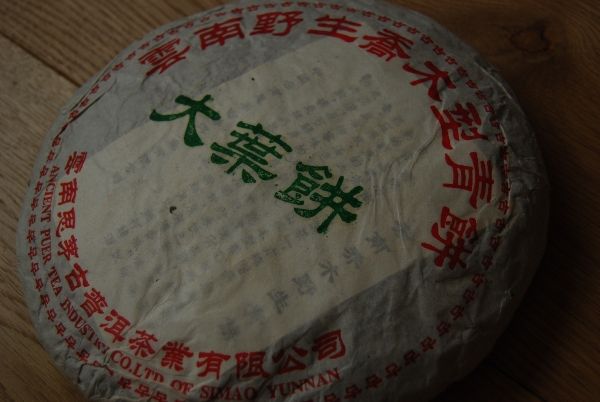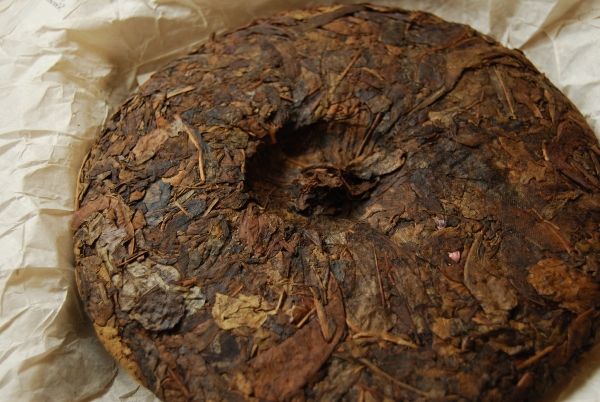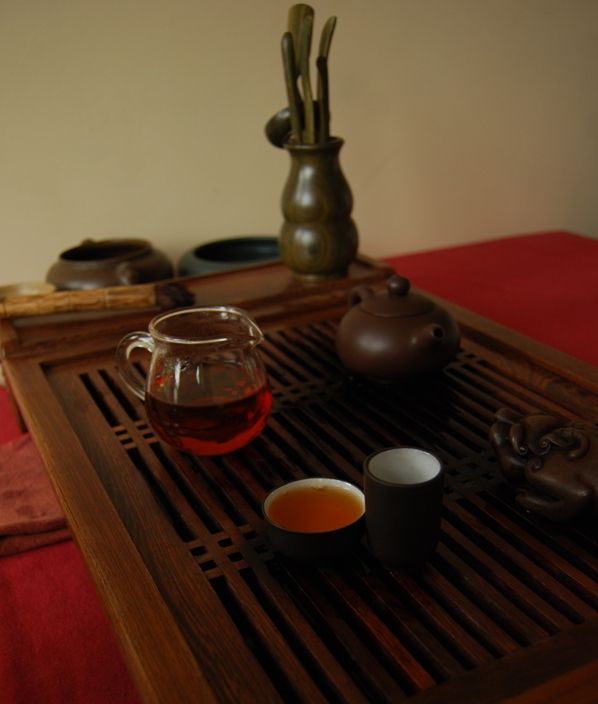Huangpian [hwang-pee-en, lit. "yellow flakes"] are the broad yellow leaves that producers often pick out of their maocha (by hand) prior to pressing. I rather prefer cakes with the huangpian left in, because they impart a little complexity. This cake, generously provided by Keng (thanks again!), is comprised entirely of huangpian.
Dayebing
The cake's name "Dayebing" [da-yeah-bing] means "big leaf cake", which is a touch misleading. "Daye" typically refers to the varietal of Yunnanese tea used to make pu'er. Of course, it is here a euphemism for huangpian.
The orange colour of this cake is particularly striking
As I have written several times before, I love exploring the whole space of pu'er - from its peaks to its troughs, from its centroids to its outliers. This is most definitely an outlier! Yet, outliers are often very enjoyable, and can have their own story to tell. This huangpian cake is no exception.
The bing itself is chubby (being about twice as thick as normal bingcha) easily squished, and very light - courtesy of the low density of the leaves used to make it.
I use lots of huangpian in order to achieve a good quantity of content in the pot
It brews remarkably cleanly - a pure, crystalline orange/red colour. The aroma is that tar-like aroma of huangpian, with a similarly clean sweetness.
In the cup, it is tart, sweet, dazzlingly clean, and really rather enjoyable. What is most striking is the pronounced cooling sensation in the mouth - it is one of the most mentholesque cakes I have encountered.
While it does not last a huge number of infusions, given the low content of the thin huangpian, it is elegant, perfectly clean, and absent any roughness.
Not a speck of leaf fragment to be found in this crystalline, pure brew
If these were the "left-over" leaves, removed from maocha, then it certainly must have been maocha of an admirable quality. There is a lot in this tea, and it has a particular finery.
The opportunity to try a good huangpian cake is most welcome; it represents one of the contributing ingredients to some of my favourite cakes, and is an ingredient which is often neglected or misunderstood. To become acquainted with an example of such quality is a rare treat. Thanks again to Keng.





5 comments:
Mmm, this sounds mighty delicious. If there is one thing I've noticed, it's that there is always something good to be done with tea leaf leftovers/processing scraps/etc. Putting every bit to good use, and getting something interesting, usually with enjoyable results. Hooray!
-Fox
Very true - even down to using the dregs of the shupu process as "tea nuggets", manufacturers have proven themselves very efficient with their resources!
Toodlepip,
Hobbes
Nice post--I've never tried a young huangpian cake, but have encountered several pressed and loose aged huangpian teas. The durability and complexity are never quite up to par with contemporaneous cakes, but the leaves do age just like regular pu-erh. What's really interesting to me is that the unblended huangpian have a really distinct flavor that is unlike most other types of pu-erh I've encountered. The leaves often seem physically different from your standard pu-erh leaves, too--more leathery and less expandable. Like your cake here, they're also often sold as "big leaf" or even "old tree," which is probably even more misleading.
I also note your mention of da ye as a tea varietal--would you really consider da ye a specific tea varietal, or more of an umbrella term for the type of Yunnan tea that is used to produce pu-erh? I know that plantation teas are likely to be cloned for specific cultivars and characteristics, but aren't sexually-propagated "wild" trees each technically genetically unique and therefore not belonging to a specific cultivar/varietal?
Best,
Zero
Dear Zero,
I find it very intrresting to try huangpian on their own. While, as you wrote, they do not age as well as basis leaves, they have a unique flavour that contributes very well to the overall complexity of a normal cake. I much prefer it when the huangpain are left in the maocha, for that reason. I find that they have a tar-like, "sticky" flavour that adds a new dimension to a tea's profile.
Of course, there are over a dozen recognised varietal classifications of organisms that provide "pu'er" leaves - "daye" is merely a colloquial term used in the PRC to describe all of them.
After all, their "ye" are rather "da".
Toodlepip,
Hobbes
Thanks for the follow-up Hobbes! I agree about the flavor--"cotton candy" is what usually ends up in my mind when I'm tasting the brew, for some reason. Probably better if that particular flavor is diluted a bit...
Post a Comment